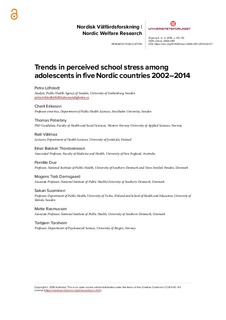| dc.contributor.author | Lofstedt, Petra | |
| dc.contributor.author | Eriksson, Charli | |
| dc.contributor.author | Potrebny, Thomas | |
| dc.contributor.author | Välimaa, Raili | |
| dc.contributor.author | Thorsteinsson, Einar | |
| dc.contributor.author | Due, Pernille | |
| dc.contributor.author | Damsgaard, Mogens Trab | |
| dc.contributor.author | Suominen, Sakari | |
| dc.contributor.author | Rasmussen, Mette | |
| dc.contributor.author | Torsheim, Torbjørn | |
| dc.coverage.spatial | Nordic countries | nb_NO |
| dc.date.accessioned | 2020-02-03T14:09:01Z | |
| dc.date.available | 2020-02-03T14:09:01Z | |
| dc.date.created | 2019-11-22T22:07:08Z | |
| dc.date.issued | 2019 | |
| dc.identifier.citation | Löfstedt, P., Eriksson, C., Potrebny, T., Välimaa, R., Thorsteinsson, E. B., Due, P., . . . Torsheim, T. (2019). Trends in perceived school stress among adolescents in five Nordic countries 2002–2014. Nordisk välfärdsforskning, 4(2), 101-112. | nb_NO |
| dc.identifier.issn | 2464-4161 | |
| dc.identifier.uri | http://hdl.handle.net/11250/2639361 | |
| dc.description.abstract | Associations between school-related stress and poor health, risk behaviours and low well-being are well documented. The aim of this paper was to estimate trends of perceived school stress experienced by boys and girls of different ages in the Nordic countries, and to describe trends in school stress between the Nordic countries. Nordic data from the Health Behaviour in School-aged Children study (HBSC) between 2002 and 2014 were used. The participants were aged 11–16 years. School stress was measured by a single item; “How pressured do you feel by schoolwork?” The participants answering “some” or “a lot” were categorised as reporting school stress.
Sweden, Norway and Denmark had lower prevalence of school stress compared to Finland and Iceland. There was an increase in Iceland, Finland and Denmark, whereas adolescents from Sweden showed a decreasing trend. In Norway, the level was stable. Boys showed a marginal decline in school stress whereas girls showed an increase, and school stress increased by age for the whole period. It is a challenge for the public education systems in the Nordic countries to develop policies and practices that provide children with the necessary tools to achieve knowledge and skill, and at the same minimise stress in school. | nb_NO |
| dc.language.iso | eng | nb_NO |
| dc.publisher | Universitetsforlaget | nb_NO |
| dc.rights | Navngivelse-Ikkekommersiell 4.0 Internasjonal | * |
| dc.rights.uri | http://creativecommons.org/licenses/by-nc/4.0/deed.no | * |
| dc.subject | perceived school stress | nb_NO |
| dc.subject | trends | nb_NO |
| dc.subject | adolescents | nb_NO |
| dc.title | Trends in perceived school stress among adolescents in five Nordic countries 2002–2014 | nb_NO |
| dc.type | Journal article | nb_NO |
| dc.type | Peer reviewed | nb_NO |
| dc.description.version | publishedVersion | nb_NO |
| dc.rights.holder | Copyright © 2019 Author(s). | nb_NO |
| dc.source.volume | 4 | nb_NO |
| dc.source.journal | Nordisk välfärdsforskning | Nordic Welfare Research | nb_NO |
| dc.source.issue | 2 | nb_NO |
| dc.identifier.doi | 10.18261/issn.2464-4161-2019-02-07 | |
| dc.identifier.cristin | 1751288 | |
| cristin.unitcode | 203,11,12,0 | |
| cristin.unitname | Senter for kunnskapsbasert praksis | |
| cristin.ispublished | true | |
| cristin.fulltext | original | |
| cristin.qualitycode | 1 | |

